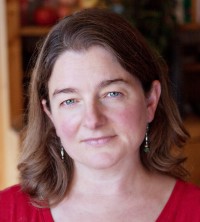Tell a story, ask a question
Our church started down its bicultural path in the kitchen of the community meal. We recognized our need for cooks who spoke English and Spanish and could help us reach out to the Spanish-speaking community beyond our boundaries. Even though a few of the English-speaking cooks spoke Spanish, this wasn’t the same as having someone who could help us bridge cultural divides, divides we only barely understood. We found the people we needed, and their coming was one of the early transformative moments for our community.
We English-speaking cooks had been working together for many years. Our philosophy of the meal had become so integrated into what we did every day that we had forgotten to articulate it.
One crucial piece was that we always ate with the people who came to the meals. We believed in this principle passionately. We had all worked in soup kitchens where the line between volunteers and guests was rigidly policed and crossing that boundary was a deep social taboo. Instead, we wanted to put an emphasis on the community in "community meal": we are all one. We share one table and one bread.
So, no matter how busy or overwhelmed the cooks in the kitchen could get, we took time to get a plate of food and sit down at one of the tables and eat. We believed this sitting spoke volumes. In fact, we believed that it spoke for itself.
It didn’t.
When Spanish-speaking cooks from Mexico and El Salvador joined the meals, we told them about our practice, and they nodded. But as time went by, I noticed that they didn’t do it. They stood in the kitchen and ate with each other. One day, I said, “Would you please go out to the tables and eat with our guests?” They nodded, went for about three minutes, and returned to the kitchen.
I was frustrated. I tried to explain why it mattered to me. They still didn’t do it. One told me that she was frightened by the people. Another that they smelled bad. Another that she was too busy with the dishes. These were exactly the kinds of attitudes we were attempting to overcome by eating with our guests, I said. We are trying to say that our connection with each other is more important than fear or busy-ness. They still didn’t go.
These were courageous, strong, compassionate women. That they did not see as I saw meant something I couldn’t quite perceive.
I took a step back. I observed that when Salvadoran and Mexican women served food to the community on Sundays, they also did not sit and eat. They loaded up plate after plate of food, but they did not sit. When did they eat? I wondered. In the kitchen, with each other, I noticed. I wondered what they saw in me when I sat and ate. I thought I was communicating connectedness with my guests, but in fact I was communicating—inadvertently—separation from my fellow laborers.
One day, I told the story of my frustration to one of the Spanish-speaking women who cooks for the meal. Instead of telling her of the practice and the principle that I held so dear, I told her about my experience and my questions. I began to ask about her own experience. A conversation developed that probed our differences.
My demand became a question—and the question remains unresolved. Chances are good that what evolves from it will come from a little bit of both our deeply held, now better articulated deepest principles.
The lesson for me seems clearer than the question of where and when cooks should eat: as we attempt to integrate two cultures into one church, we have two simultaneous responsibilities.
One is to tell our stories: What brought us together? What have our struggles been? How did various commitments emerge, and what life did they take on through the years? We don’t do this to create a divide between those who came before and those who are here now. We do it so that we can know one another.
The second thing is to ask questions that invite stories in return. Instead of saying, “Do as I do,” I can say, “I notice that you all eat in the kitchen. What is the story behind that?”
These are questions that Parker Palmer calls “open and honest,” questions to which I do not and cannot know the answer. Denise Levertov articulates this in her poem “A Gift”:
You are given the questions of others
as if they were answers
to all you ask. Yes, perhaps
this gift is your answer.






